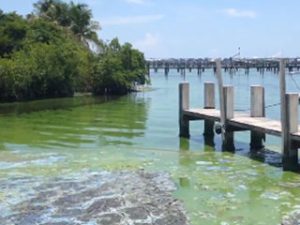NCCOS, through its HAB Event Response program, in response to a request from the Martin County Board of County Commissioners, has provided funds and identified experts to track the recent bloom in Lake Okeechobee that began in May and has expanded to the largest cyanobacterial bloom in the state in at least 10 years.

NCCOS provided funds to support sampling and toxin analyses in estuaries and coastal waters and provided satellite images to track the bloom. Martin County will provide monitoring results to the State Emergency Operations Center, and will release final results to the public. The NOAA funding came after the county contacted NCCOS for help in dealing with concerns for public health, particularly in county areas where the likelihood of human exposure is high, such as marinas and beaches.
Martin County is a popular tourist area located at the mouth of the St. Lucie Estuary. The bloom originated in Lake Okeechobee in May, eventually covering 200 square miles of the lake, and moving through the C-44 Canal a (St. Lucie River) into the St. Lucie Estuary as the lake was drained to protect the integrity of the dike encircling the Lake.
The Martin County Board of County Commissioners issued a formal declaration of emergency on June 29, 2016 in response to the economic, public health, and ecological impacts of the bloom.
The bloom is predominantly in freshwater, so EPA Region 4 is leading the Federal response. NCCOS HAB Event Response funding supports that response, and is directed where the bloom has moved into estuaries and coastal waters. The satellite imagery products are part of the Cyanobacteria Assessment Network (CyAN) project, a collaborative effort between U.S. EPA, NASA, NOAA, and USGS to provide early warning of cyanobacteria and other toxic and nuisance algae blooms.
For more information on the HAB Event Response Program, contact Quay.Dortch@noaa.gov and Marc.Suddleson@noaa.gov .
